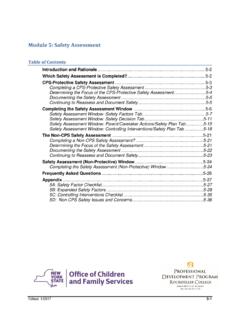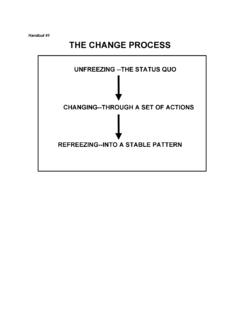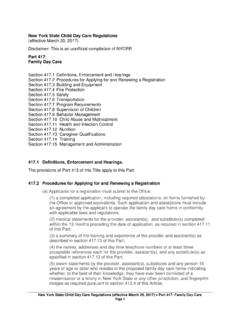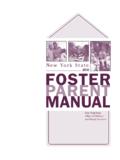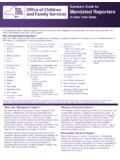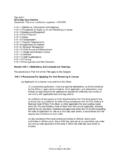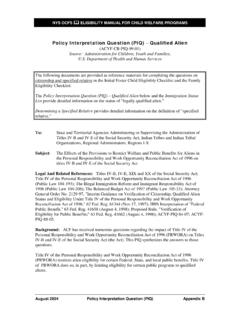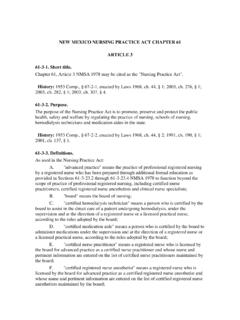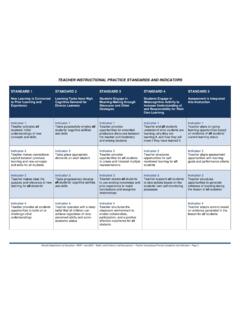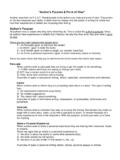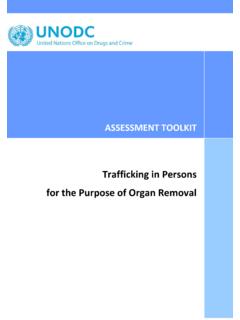Transcription of Identifying and Making Referrals for Appropriate Services ...
1 Identifying and Making Referrals for Appropriate Services : Best practices Guidelines I. purpose The purpose of this document is to provide best practice guidelines as well as a summary of the applicable law and OCFS policy guidance to assist local district Adult Protective Services (APS) staff when Making Services Referrals . II. Introduction Local departments of social Services (LDSS), through the efforts of Adult Protective Services , are charged with receiving and addressing APS Referrals from various sources, both professionally and directly from the community, including family members.
2 Some Referrals that APS receives do not warrant an investigation; some are simply information and referral which APS staff provides, based on the specific concerns of the referral source. Examples of this include providing telephone numbers for other agencies within the community and explaining the criteria to receive APS intervention. APS initially evaluates the reported situation in a timely manner and determines whether the person is eligible to receive Services . APS looks for risk factors affecting the safety and well- being of the person. For clients with decision- Making capacity, the willingness of the person to receive Services is a key factor in the case remaining open for any length of time.
3 Once eligibility for Services is confirmed, a thorough assessment of risk and need is done within 60 days of referral date. Thereafter, ongoing assessments are conducted on open cases every six months. Assessments are individualized to meet the specific needs of each client. Often, this means Making a referral to community-based agencies that provide the identified service to keep the client safely residing in the home (when possible). Assessments reflect the current needs and risks of the client, so service plans change accordingly. In some APS cases, the needs of the client are such that they do not require the assistance of community service providers.
4 Some examples of this include monthly home visits by an APS caseworker for safety monitoring purposes, formal financial management of Social Security funds through Representative Payee Services , and informal financial management conducted by the caseworker. Some LDSSs have case aides or similar staff positions who can do shopping and errands for clients who are ineligible for Medicaid-funded home care or personal care. Staff can also assist with transportation to appointments for persons with no other available transportation options. APS also serves involuntary persons who need assistance.
5 This population is handled differently due to legal considerations, and will be addressed in section VI. 1. III. Risk Factors and Services Offered to Address the Needs of APS Clients There are numerous risk factors that APS clients face, including: lack of food and clothing;. lack of shelter leading to homelessness or displacement;. lack of medical care, including mental health treatment;. inability to adequately access benefits (Medicaid, SNAP, Temporary Assistance and Veteran's Administration, Social Security Administration);. correction of home environmental factors (heavy duty cleaning and/or insect/rodent extermination, safety related home maintenance repairs).
6 Inability to pay bills leading to utility shut off, eviction, etc.;. lack of transportation to medical and other appointments;. inability to adequately perform activities of daily living (ADLs);. social and or physical isolation; and when a higher level of care is needed but the client is unable to advocate for self. APS caseworkers and supervisors must be able to recognize risk factors in the clients they serve. These include signs of physical abuse, self or caregiver neglect, and financial exploitation. Deteriorating conditions should be addressed in a timely manner to avoid a crisis or emergency situation involving medical and or mental health.
7 Service providers who meet the needs of APS clients come in many forms: some are governmental agencies; some are non-profit or for-profit agencies that serve the community in a variety of ways. Even an informal support system of neighbors, friends and family can serve the APS clients in eliminating or reducing their safety risks from living independently in the community. Good casework practice includes knowing about the resources in the community and how to access them. It is important for APS to build and maintain good working relationships with other agencies, landlords, home repair Services , deep cleaning Services , hospitals, other medical facilities, home health agencies, homeless shelters, food pantries and soup kitchens, other departments within LDSS, domestic violence Services , substance abuse Services , law enforcement and counseling and case management Services .
8 All these entities serve APS. clients in reducing risk and increasing independence. 18 NYCRR provides that the responsibilities of each LDSS include: Maintaining a resource inventory of Services provided by the social Services district and of Services available from other public and private community agencies. It is therefore important that all caseworkers, especially new ones, have access to an up-to- date inventory or list of service providers in the community. Experienced supervisors and caseworkers may be the best resource for the APS unit, especially for new staff.
9 Another good practice is for APS supervisors to have periodic meetings with administrators of service providing agencies in the community. Engaging in community coalitions, task forces, and committees is a good way to develop and sustain relationships with APS service providers. This type of engagement is more likely to create and sustain collaborations that produce the best outcomes for APS clients. Ongoing outreach is a good preventative practice that helps to keep the lines of communication open. Some examples of this are community sponsored 2. wellness fairs, Office for the Aging (OFA) social events, and Single Point of Entry (SPOE).
10 Meetings. OCFS provides LDSSs with brochures, posters and other materials for the purposes of outreach and public education. Keep in mind, although the community service providers are there to support APS clients, case outcomes can be affected by factors such as the degree of client cooperation, funding availability and staff resources. In some instances, a Memorandum of Understanding (MOU) between APS and another agency can keep the roles and expectations clear. IV. Assessment / Service Plan: The Road Map to Success The written service plan/assessment is the best way to identify exactly what the client's risks are and what Services are needed to correct the situation.
